Second Strike, the themed exhibition at the third Herzliya Biennale, mounted in cooperation with ArtTLV, with some 40 artists from Israel and abroad participating, features many excellent works. Its central venue is the city’s Art Museum. From there, the show spills out onto the street, to the Bus Station for instance, where one finds the eye-catching fantasy posters of Peter Wächtler (2006), a German artist living in Belgium; and Lichtkiele (2010), Polish artist Miroslav Balka’s entrancing spiral mobiles. Exhibits can also be found in small cultural venues off the main streets, and, in two basement spaces that, in tune with the show’s theme, curator Ory Dessau has described as bunkers.
The melodramatic title, the description given to a country’s ability to respond to a ‘first strike’ nuclear attack, is employed here as a convenient lynch pin for a diverse range of installations, photographs, paintings and video pieces that touch on such subjects as power, aggression and destruction. But apart from Launching Apparatus (2008), aluminum replicas of Kassam missiles by the late Gideon Gechtman, none of the works carry strong, specific messages. Interpretation is invariably left to the viewer.
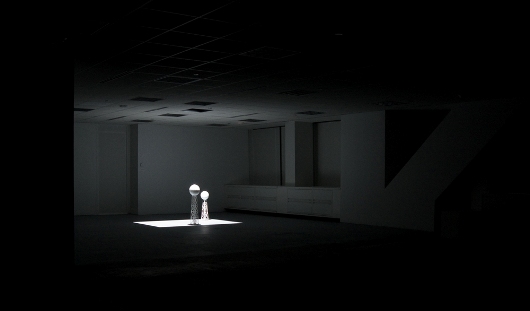
A sense of power, but also of vulnerability, emanates from No 4 (Towers ) Jan Tichy‘s visually haunting piece (located in the Municipal Gallery.) Constructed from paper, one meter high, it comprises two towers surmounted by circular objects. The identity of these structures is unknown, but they may allude to secret installations located in isolated areas away from prying eyes. The illumination of these towers is governed by the progress of a video loop, a beam that starts as a mere slit to expand fully before leaving them to sink back into darkness.
Swiss artist Christoph Büchel‘s video Parade from 2005 (in the Museum) takes a humorous look at the trappings of power. Its footage is taken from an aerial view of a military parade in Teheran, originally uploaded onto the website of the Israeli Foreign Ministry, as counter-propaganda. With clerics and other leading dignitaries solemnly looking on, hundreds of soldiers, colored flags flying from their rifles, march and trot in formation or come together to form different configurations, such as missiles, the Star of David and a swastika.
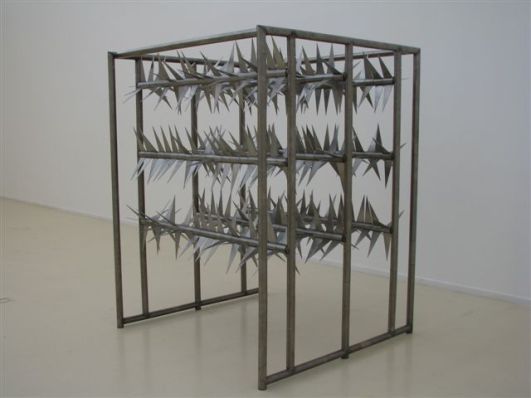
Works by Fabrice Gygi, Lothar Hempel and Adam Rabinowitz in the largest gallery of the Museum demonstrate conclusively that the concept of Second Strike refers also to the struggles of contemporary artists to find new ways of expression, or even, to invent new worlds. Swiss artist Gygi shows two strange objects which can viewed as abstract pieces: Adaption bag, a black leather sac hanging from the ceiling; and Star System (2008) a floor-based steel cell crisscrossed by serrated blades. Even thought these are inanimate objects with no obvious function, they bring to mind instruments of torture, and thus appear as a potential threat.

A sense of foreboding and threat is also a feature of Michal Helfman‘s dramatic sculpture (sited in an adjacent gallery). It comprises a mirrored tableau that reaches almost from floor to ceiling made up from great folds of silvered synthetic fabric; a scene that hints at the presence of people lurking behind this silky façade. To add to the mystery, two draped figures, like holy mendicants, carry begging trays. On them are small stones with the words FOR GIVE and FOR GET etched into them.
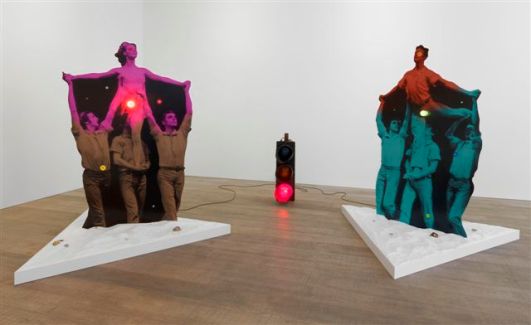
Sited opposite Gygi’s cage is Verkehr (German for ‘traffic’, and also a euphemism for sex), Berlin artist Hempel’s placard-like installation in which novel effects are produced by combining flat sculpture with photography. The photos, glued to boards and mounted on a plinth which rests in a bed of sand, display double image of dancers snapped at a transcendental moment. Nina Canell, from Sweden, is another artist who is broadening traditional conceptions of art-making. Her sculptural installations are not static but incorporate sound, light, water, steam and electromagnets. Here, in the Museum, she is showing Another Ode to Outer Ends (2010), one of her fascinating ‘evaporation works’, in which clouds of steam rise from a bucket of water which is fitted with a mist machine and a sound generator.
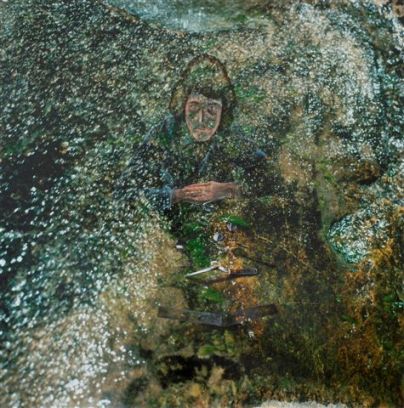
A set of portraits by Ruti Nemet also indicates a willingness to experiment. Prints, rapidly exposed photos of water flowing over rocks, form the background to her fine paintings in which the face of her subject emerges in flickering waves of color speckled with white. In one instance she turns the psychic Uri Geller surrounded by his bent spoons into a ghostly vision.
Escaping from the real world into fantasy, Rabinowitz, the third artist in the largest Museum gallery, has built a domed retreat that could be taken for a nuclear reactor, or perhaps just an outsize igloo. The character of its interior, a cave like-space containing two stalagmite-like shapes, paintings of distant shores, and shadow imagery, is not clearly defined.
In Room 204 –Voices, Zvi Goldstein‘s intriguing two part installation, fantasy, hallucinations and reality come together. In one room, the walls are studded with acoustic vents. Putting one’s ear close to them, voices can be heard reciting passages from Room 205, Goldstein’s book of poetry, an apparent recreation of a minute long hallucinatory experience that took place in 2005 between 9:25 and 9:26 a.m. in Room no. 205 at a hotel in Tel Aviv.
In an adjoining room is his Reconstructed Memory (2001-2005) where charts, photographs and strange objects –such as a dried lizard on a silver mountain, and the leathery armor shell of an armadillo seen through peepholes – refer to another traumatic hallucination. One that Goldstein experienced in Africa, on the banks of the Chari River, between Chad and Cameroon.
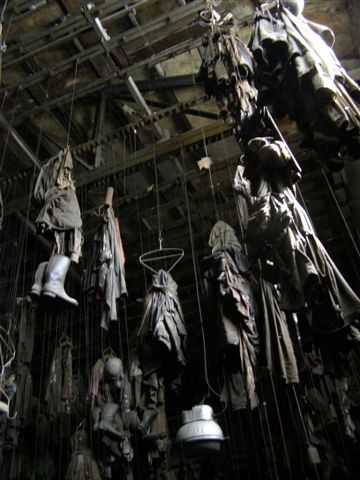
There are many other works in this exhibition that are truly worth seeing. Certainly not to be missed (in the basement of 53 Sokolov St.) is Polish artist Robert Kusmirowski‘s Deposit Point (2011), a work that involved the transformation of a basement hall into a locker room for miners, realistic in every detail. Chains and other equipment hang from the walls; and suspended by hooks from the ceiling are row upon row of garments, boots and shoes, both working clothing and casual wear. Immaculately fabricated, one might believe that this place is a genuine relic of the past that would not be out of place in an ethnological museum. But the mine that Kusmirowski recreates – judging by a notice on the wall- at Bogdanka in East Poland is a working facility. If one wonders how this installation links up to the theme of the exhibition, then one should read this notice. It calls for the mine workers of Bogdanka to rise up and strike.
The Second Strike exhibition at the Herliya Museum for Contemporary Art will be open through December 31, 2011. The museum is located on 4 Ha’banim Street, Herzliya. For additional information consult the museum website or call: 09-9551011.





